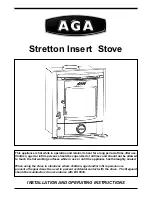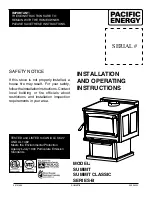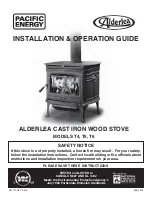
12
LIGHTING
Before lighting the stove check with the installer
that the installation work and commissioning
checks described in the installation instructions
have been carried out correctly and that the
chimney has been swept clean, is sound and
free from any obstructions. As part of the stoves
commissioning and handover the installer
should demonstrate how to operate the stove
correctly.
IMPORTANT: The first few fires should be rela-
tively small to permit the refractory to set prop-
erly and to season the stove.
1. Before lighting the stove, ensure that any build-
up in the firebox has been removed and that the
ashpan has been emptied.
2. Open the spin valve by turning it anti-clockwise.
Open secondary air control by pulling it down.
These parts will become hot. Use the tool
provided.
3. Lay a few crumpled sheets of paper on the grate
and then a few small sticks, kindling or an
approved firelighter. Ignite and close the door.
4. Never use inflammable liquid i.e. gasoline,
petrol paraffin etc. to start or freshen up a fire in
this heater.
5. When the fire is well established add fuel to the
firebox. Adjust to the desired setting the spin
valve and / or the secondary air slide depending
on the fuel burned. (See Re-Fuelling Section).
6. To shut the fire down, do not add fuel. Make
sure that the fire door is properly closed, that
the spin valve is firmly shut and the secondary
air slide is pushed up. Cutting off the air supply
will reduce the heat output.
FIRE SAFETY
To provide reasonable fire safety the following
should be given serious consideration:
1. The installation of smoke detectors.
2. A conveniently located fire extinguisher to con-
tend with small fires resulting from burning
embers.
3. A practical evacuation plan.
4. A plan to deal with a chimney fire as follows:
a.
Notify the fire department.
b. Prepare occupants for immediate evacua-
tion.
c. Close all openings into the stove.
d. While awaiting the fire department watch for
ignition to adjacent combustibles from over
head stove pipe or from embers or from
sparks from the chimney.
GLASS
1. How to clean:
The glass will clean itself when there is sufficient
heat generated by burning fuel. If a build-up of cre-
osote occurs on the glass it may be due to draft con-
ditions, poor quality fuel or very slow burning for a
long time. Only clean glass when the stove is thor-
oughly cooled. Clean with a liquid detergent taking
care not to scratch the glass with any coal ash
deposits.
2. Glass Replacement:
a. Open the door fully.
b. Remove the clips and carefully remove the
broken glass.
c. Clean the glass recess in the door.
d. Place the glass into the door recess and replace
the four corner clips.
e. Tighten screws.
f. Replace glass only with ceramic glass 5mm thick.
SUMMER SHUTDOWN
For summer shutdown of the stove, ensure all ashes
have been cleaned from the ash compartment and
that the air control is open, to avoid condensation in
the stove firebox and possible corrosion during this
shutdown period.
Summary of Contents for Stretton
Page 14: ...13 NOTES ...
Page 15: ...14 NOTES ...


































